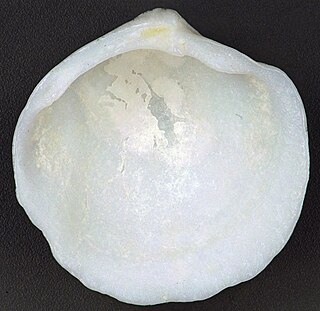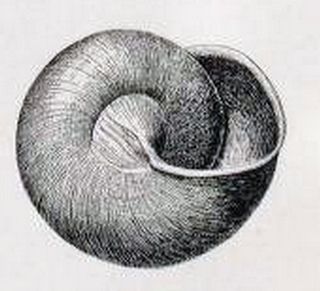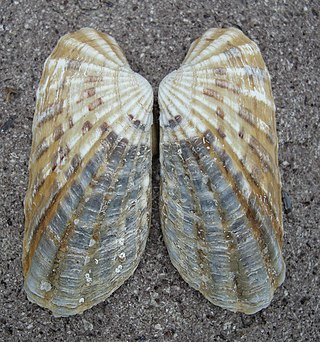
The shipworms are marine bivalve molluscs in the family Teredinidae: a group of saltwater clams with long, soft, naked bodies. They are notorious for boring into wood that is immersed in sea water, including such structures as wooden piers, docks and ships; they drill passages by means of a pair of very small shells (“valves”) borne at one end, with which they rasp their way through. They are sometimes called "termites of the sea". Carl Linnaeus assigned the common name Teredo to the best-known genus of shipworms in the 10th edition of his taxonomic magnum opus, Systema Naturæ (1758).

Bivalvia, in previous centuries referred to as the Lamellibranchiata and Pelecypoda, is a class of marine and freshwater molluscs that have laterally compressed bodies enclosed by a shell consisting of two hinged parts. As a group, bivalves have no head and they lack some usual molluscan organs, like the radula and the odontophore. The class includes the clams, oysters, cockles, mussels, scallops, and numerous other families that live in saltwater, as well as a number of families that live in freshwater. The majority are filter feeders. The gills have evolved into ctenidia, specialised organs for feeding and breathing. Most bivalves bury themselves in sediment, where they are relatively safe from predation. Others lie on the sea floor or attach themselves to rocks or other hard surfaces. Some bivalves, such as the scallops and file shells, can swim. The shipworms bore into wood, clay, or stone and live inside these substances.

Lucinidae, common name hatchet shells, is a family of saltwater clams, marine bivalve molluscs.

Lienardia rigida is a species of sea snail, a marine gastropod mollusk in the family Clathurellidae.

Lucina pensylvanica, commonly known as the Pennsylvania lucine, is a species of bivalve mollusc in the family Lucinidae.

Anodontia alba, or the buttercup lucine, is a species of bivalve mollusc in the family Lucinidae. It can be found along the Atlantic coast of North America, its range extending from North Carolina in the United States to the West Indies.
Anodontia philippiana, or the chalky buttercup, is a species of bivalve mollusc in the family Lucinidae. It can be found burrowing in soft substrate in shallow waters along the Atlantic coast of North America, its range extending from North Carolina in the United States to the West Indies and Bermuda.

Codakia orbicularis, or the tiger lucine, is a species of bivalve mollusc in the family Lucinidae. It can be found along the Atlantic coast of North America, ranging from Florida to the West Indies.

Ctena orbiculata, commonly known as the dwarf tiger lucine, is a species of bivalve mollusc in the family Lucinidae. It can be found along the Atlantic coast of North America, ranging from North Carolina to the West Indies.

Divaricella quadrisulcata, or the cross-hatched lucine, is a species of marine bivalve mollusc in the family Lucinidae. D. quadrisulcata, also known as Divalinga quadrisulcata, are known for their unique shell patterns. The shells of D. quadrisulcata have been used as jewelry and can be collected along the shore in many Atlantic coastal states in North America. These organisms are known to have a symbiotic relationship with sulfur-oxidizing bacteria, as is characteristic of many other organisms within the family Lucinidae.
Granigyra filosa is a species of sea snail, a marine gastropod mollusk, unassigned in the superfamily Seguenzioidea.

Tegula cooksoni is a species of sea snail, a marine gastropod mollusk in the family Tegulidae.

Gaza rathbuni, common name Rathbun's gaza, is a species of sea snail, a marine gastropod mollusk in the family Margaritidae.

Calliostoma leanum, common name the pretty mouth, is a species of sea snail, a marine gastropod mollusk in the family Calliostomatidae.
Puncturella expansa, common name the broad puncturella, is a species of sea snail, a marine gastropod mollusk in the family Fissurellidae, the keyhole limpets and slit limpets.

Fissurella virescens, also known as the green Panama keyhole limpet, is a species of sea snail, a marine gastropod mollusk in the family Fissurellidae, the keyhole limpets and slit limpets.

Codakia is a genus of saltwater clams, marine bivalve molluscs in the family Lucinidae.
Stewartia floridana is a bivalve of the family Lucinidae that is chemosymbiotic with sulfur-oxidizing bacteria.

Lucina is a genus of saltwater clams, marine bivalve molluscs.

Carditamera affinis is a species of marine bivalve mollusc. It was first described to science by George Brettingham Sowerby I in 1833. No English common name has been recorded for this species. The first appearance of this animal in the fossil record is 5.333 million years ago.

















